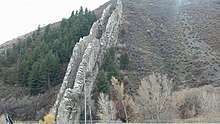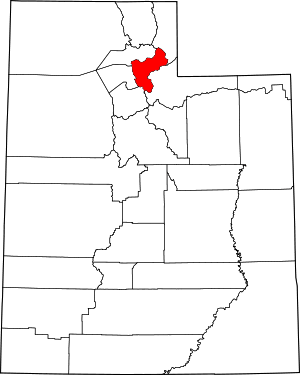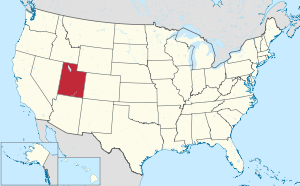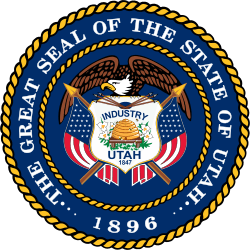Morgan County, Utah
Morgan County is a county in northern Utah, United States. As of the 2010 census, the population was 9,469.[1] Its county seat and largest city is Morgan.[2] Morgan County is part of the Ogden-Clearfield, UT Metropolitan Statistical Area as well as the Salt Lake City-Provo-Orem, UT Combined Statistical Area.
Morgan County | |
|---|---|
 Devil's Slide, a limestone rock formation in Weber Canyon, November 2013. | |
 Location within the U.S. state of Utah | |
 Utah's location within the U.S. | |
| Coordinates: 41.08°N 111.58°W | |
| Country | |
| State | |
| Founded | January 17, 1862 |
| Named for | Jedediah Morgan Grant |
| Seat | Morgan |
| Largest city | Morgan |
| Area | |
| • Total | 611 sq mi (1,580 km2) |
| • Land | 609 sq mi (1,580 km2) |
| • Water | 1.7 sq mi (4 km2) 0.3% |
| Population (2010) | |
| • Total | 9,469 |
| • Estimate (2019) | 12,124 |
| • Density | 20/sq mi (8/km2) |
| Time zone | UTC−7 (Mountain) |
| • Summer (DST) | UTC−6 (MDT) |
| Congressional district | 1st |
| Website | www |
History
An early route of the Hastings Cutoff ran through the Morgan Valley and down through a narrow gorge in Weber Canyon. The Donner Party avoided going through the Morgan Valley in order to speed up their journey. However, their alternate route proved more time-consuming.
In 1855, Charles Sreeve Peterson and his family became the first white settlers to take up permanent residence in the Morgan Valley after cutting a road through Weber Canyon. After others began settling in the rather limited planar areas of the mountainous territory, the Utah Territory legislature acted on January 17, 1862 to form a separate county from sections partitioned off Davis, Great Salt Lake, Summit, and Weber counties. The small settlement at Morgan was named the county seat. The town (and thus the new county) was named for the father (Jedediah Morgan Grant) of Heber J. Grant, who would serve as president of LDS Church from 1918 until 1945.[3]
Geography
The central core of Morgan County, the narrow East Canyon valley (now called Morgan Valley), is ringed by mountains. In its southern portion, Main Canyon Creek flows southward from Summit County to join East Canyon Creek, which flows northward from a different portion of Summit County. At their intersection, a dam has been installed to create East Canyon Reservoir and State Park. The combined discharge (now called East Canyon Creek) from the dam flows northwestward to Morgan, where it combines with Deep Creek to discharge into the Weber River, which also flows into the county from Summit and follows Lost Canyon to the Morgan Valley. The now-augmented Weber flows northwestward to Mountain Green, then turns west to exit the county through Weber Canyon.[4] The terrain generally slopes to the north and west, with its highest point, Thurston Peak[5] at 9,706' (2958m) ASL.[6] The county has an area of 611 square miles (1,580 km2), of which 609 square miles (1,580 km2) is land and 1.7 square miles (4.4 km2) (0.3%) is water.[7] It is Utah's third-smallest county by land area and smallest by total area.
Major highways[4]

- Utah State Highway U-65
- Utah State Highway U-66
- Utah State Highway U-158
- Utah State Highway U-167
Some county roads accessing the canyons are closed during winters.
Adjacent counties
- Weber County - north
- Summit County - east
- Salt Lake County - southwest
- Davis County - west
- Rich County - northeast
Protected areas[4]
- Cache National Forest (part)
- East Canyon State Park
- Lost Creek State Park
- Round Valley Wildlife Management Area
- Wasatch National Forest (part)
Lakes[4]
- Bohman Hollow
- Echo Park Reservoir
- Lost Creek Reservoir
- Northwest Reservoir
Demographics
| Historical population | |||
|---|---|---|---|
| Census | Pop. | %± | |
| 1870 | 1,972 | — | |
| 1880 | 1,783 | −9.6% | |
| 1890 | 1,780 | −0.2% | |
| 1900 | 2,045 | 14.9% | |
| 1910 | 2,467 | 20.6% | |
| 1920 | 2,542 | 3.0% | |
| 1930 | 2,536 | −0.2% | |
| 1940 | 2,611 | 3.0% | |
| 1950 | 2,519 | −3.5% | |
| 1960 | 2,837 | 12.6% | |
| 1970 | 3,983 | 40.4% | |
| 1980 | 4,917 | 23.4% | |
| 1990 | 5,528 | 12.4% | |
| 2000 | 7,129 | 29.0% | |
| 2010 | 9,469 | 32.8% | |
| Est. 2019 | 12,124 | 28.0% | |
| US Decennial Census[8] 1790–1960[9] 1900–1990[10] 1990–2000[11] 2010–2018[1] 2019[12] | |||
As of the 2000 United States Census, there were 7,129 people, 2,046 households, and 1,782 families in the county. The population density was 11.7/sqmi (4.52/km²). There were 2,158 housing units at an average density of 3.54/sqmi (1.37/km²). The racial makeup of the county was 98.11% White, 0.04% Black or African American, 0.18% Native American, 0.15% Asian, 0.45% from other races, and 1.07% from two or more races. 1.44% of the population were Hispanic or Latino of any race.
There were 2,046 households out of which 49.70% had children under the age of 18 living with them, 79.60% were married couples living together, 5.60% had a female householder with no husband present, and 12.90% were non-families. 11.70% of all households were made up of individuals and 5.80% had someone living alone who was 65 years of age or older. The average household size was 3.48 and the average family size was 3.81.
The county population contained 37.10% under the age of 18, 9.70% from 18 to 24, 24.30% from 25 to 44, 20.20% from 45 to 64, and 8.70% who were 65 years of age or older. The median age was 28 years. For every 100 females, there were 102.90 males. For every 100 females age 18 and over, there were 99.70 males.
The median income for a household in the county was $50,273, and the median income for a family was $53,365. Males had a median income of $42,350 versus $23,036 for females. The per capita income for the county was $17,684. About 3.70% of families and 5.20% of the population were below the poverty line, including 5.70% of those under age 18 and 6.90% of those age 65 or over.
Politics
Morgan County traditionally votes Republican. In only one national election since 1948 has the county selected the Democratic Party candidate (as of 2016).
| Year | Republican | Democratic | Third parties |
|---|---|---|---|
| 2016 | 61.4% 3,188 | 11.1% 577 | 27.5% 1,427 |
| 2012 | 89.5% 4,114 | 8.8% 403 | 1.7% 80 |
| 2008 | 79.1% 3,311 | 16.5% 689 | 4.5% 188 |
| 2004 | 85.9% 3,301 | 12.3% 472 | 1.8% 68 |
| 2000 | 77.7% 2,464 | 17.4% 553 | 4.9% 154 |
| 1996 | 57.1% 1,659 | 29.5% 859 | 13.4% 390 |
| 1992 | 45.5% 1,339 | 17.7% 520 | 36.8% 1,081 |
| 1988 | 73.6% 1,889 | 25.2% 647 | 1.2% 31 |
| 1984 | 79.6% 1,934 | 19.8% 481 | 0.6% 15 |
| 1980 | 81.5% 1,985 | 15.3% 373 | 3.2% 77 |
| 1976 | 63.0% 1,356 | 32.5% 701 | 4.5% 97 |
| 1972 | 71.5% 1,456 | 17.8% 363 | 10.7% 217 |
| 1968 | 59.9% 1,020 | 32.4% 551 | 7.8% 132 |
| 1964 | 40.7% 572 | 59.4% 835 | |
| 1960 | 55.4% 775 | 44.5% 622 | 0.1% 1 |
| 1956 | 67.4% 905 | 32.6% 438 | |
| 1952 | 64.9% 862 | 35.1% 467 | |
| 1948 | 46.4% 587 | 53.0% 670 | 0.6% 8 |
| 1944 | 44.4% 535 | 55.6% 671 | |
| 1940 | 45.1% 575 | 54.9% 699 | |
| 1936 | 39.3% 483 | 60.2% 739 | 0.5% 6 |
| 1932 | 48.3% 568 | 51.2% 602 | 0.4% 5 |
| 1928 | 53.0% 513 | 46.9% 454 | 0.1% 1 |
| 1924 | 54.1% 482 | 40.4% 360 | 5.5% 49 |
| 1920 | 57.6% 544 | 42.0% 397 | 0.4% 4 |
| 1916 | 48.5% 464 | 50.6% 484 | 0.8% 8 |
| 1912 | 36.6% 318 | 26.8% 233 | 36.6% 318 |
| 1908 | 58.2% 494 | 36.0% 306 | 5.8% 49 |
| 1904 | 57.3% 492 | 36.7% 315 | 6.1% 52 |
| 1900 | 51.7% 391 | 48.0% 363 | 0.3% 2 |
| 1896 | 19.2% 138 | 80.8% 582 |
See also
References
- "State & County QuickFacts". United States Census Bureau. Archived from the original on June 6, 2011. Retrieved December 29, 2013.
- "Find a County". National Association of Counties. Retrieved June 7, 2011.
- Newberry Library. Individual County Chronologies/Morgan County UT (accessed March 27, 2019)
- Morgan County UT Google Maps (accessed 27 March 2019)
- Thurston Peak Google Maps (accessed 27 March 2019)
- "Utah County High Points/Morgan Co. Peakbagger (accessed 27 March 2019)". Archived from the original on March 27, 2019. Retrieved March 28, 2019.
- "2010 Census Gazetteer Files". US Census Bureau. August 22, 2012. Retrieved June 25, 2015.
- "US Decennial Census". US Census Bureau. Retrieved June 25, 2015.
- "Historical Census Browser". University of Virginia Library. Retrieved June 25, 2015.
- Forstall, Richard L., ed. (June 25, 1995). "Population of Counties by Decennial Census: 1900 to 1990". US Census Bureau. Retrieved March 27, 2015.
- "Census 2000 PHC-T-4. Ranking Tables for Counties: 1990 and 2000" (PDF). US Census Bureau. April 2, 2001. Retrieved June 25, 2015.
- "QuickFacts. Utah counties". Retrieved May 17, 2020.
- Leip, David. "Atlas of US Presidential Elections". uselectionatlas.org. Retrieved March 31, 2018.
- "Croyden". Geographic Names Information System. United States Geological Survey.
- "Milton". Geographic Names Information System. United States Geological Survey.
- "Richville". Geographic Names Information System. United States Geological Survey.
- "Sotddard". Geographic Names Information System. United States Geological Survey.
- https://www.intermountainhistories.org/items/show/267
Further reading
- Smith, Linda H. (1999). A History of Morgan County. Salt Lake City UT: Utah State Historical Society. ISBN 978-0-913738-36-8.
